Beijing Opera
- 格式:doc
- 大小:45.50 KB
- 文档页数:8
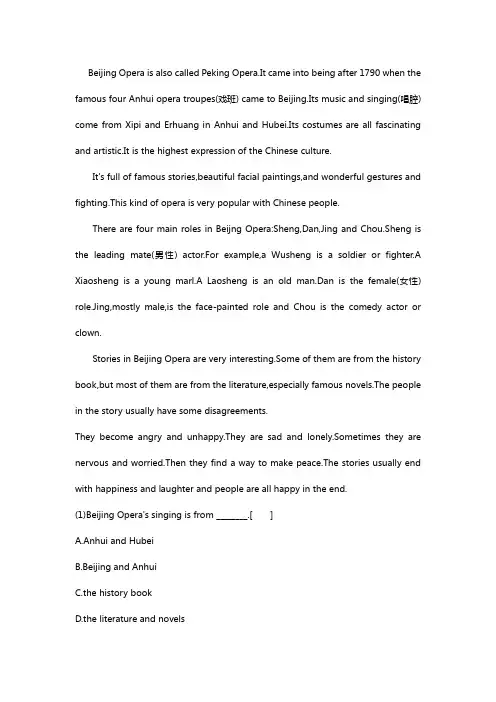
Beijing Opera is also called Peking Opera.It came into being after 1790 when the famous four Anhui opera troupes(戏班) came to Beijing.Its music and singing(唱腔) come from Xipi and Erhuang in Anhui and Hubei.Its costumes are all fascinating and artistic.It is the highest expression of the Chinese culture.It's full of famous stories,beautiful facial paintings,and wonderful gestures and fighting.This kind of opera is very popular with Chinese people.There are four main roles in Beijng Opera:Sheng,Dan,Jing and Chou.Sheng is the leading mate(男性) actor.For example,a Wusheng is a soldier or fighter.A Xiaosheng is a young marl.A Laosheng is an old man.Dan is the female(女性) role.Jing,mostly male,is the face-painted role and Chou is the comedy actor or clown.Stories in Beijing Opera are very interesting.Some of them are from the history book,but most of them are from the literature,especially famous novels.The people in the story usually have some disagreements.They become angry and unhappy.They are sad and lonely.Sometimes they are nervous and worried.Then they find a way to make peace.The stories usually end with happiness and laughter and people are all happy in the end.(1)Beijing Opera's singing is from ________.[ ]A.Anhui and HubeiB.Beijing and AnhuiC.the history bookD.the literature and novels(2)The second paragraph(段落) of the reading is about the ________ of Beijing Opera.[ ]A.storiesB.rolesC.gesturesD.paintings(3)From the reading,we know the role Chou most probably has a(n) ________ feature.[ ]A.honestB.funnyC.dullD.serious(4)Which of the following statements is TRUE?[ ]A.Peking Opera is full of different gestures.B.There are only four roles in Beijing Opera.C.Beijing Opera is the most popular in the world.D.The people in the story usually are in agreement.答案:1.A 2.B 3.B 4.A。
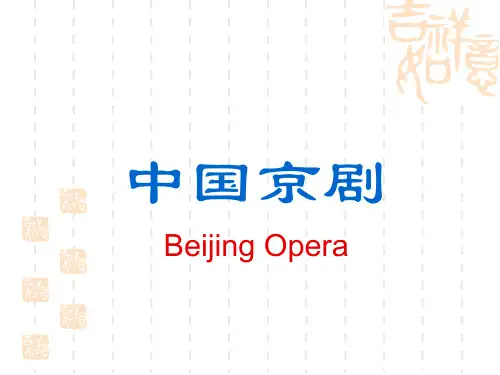
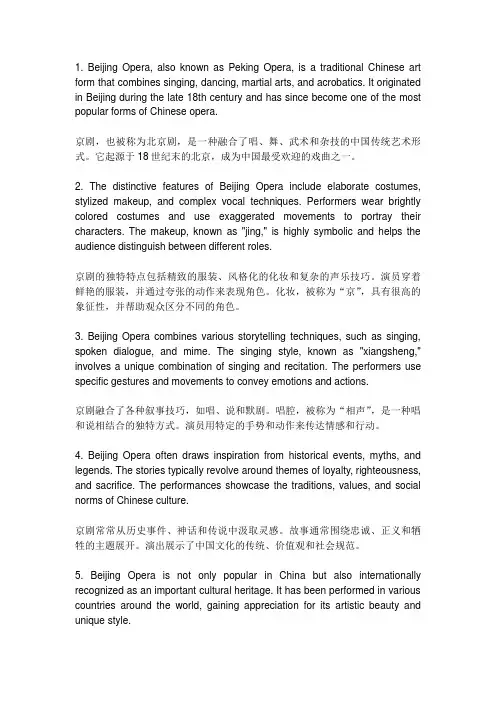
1. Beijing Opera, also known as Peking Opera, is a traditional Chinese art form that combines singing, dancing, martial arts, and acrobatics. It originated in Beijing during the late 18th century and has since become one of the most popular forms of Chinese opera.京剧,也被称为北京剧,是一种融合了唱、舞、武术和杂技的中国传统艺术形式。
它起源于18世纪末的北京,成为中国最受欢迎的戏曲之一。
2. The distinctive features of Beijing Opera include elaborate costumes, stylized makeup, and complex vocal techniques. Performers wear brightly colored costumes and use exaggerated movements to portray their characters. The makeup, known as "jing," is highly symbolic and helps the audience distinguish between different roles.京剧的独特特点包括精致的服装、风格化的化妆和复杂的声乐技巧。
演员穿着鲜艳的服装,并通过夸张的动作来表现角色。
化妆,被称为“京”,具有很高的象征性,并帮助观众区分不同的角色。
3. Beijing Opera combines various storytelling techniques, such as singing, spoken dialogue, and mime. The singing style, known as "xiangsheng," involves a unique combination of singing and recitation. The performers use specific gestures and movements to convey emotions and actions.京剧融合了各种叙事技巧,如唱、说和默剧。
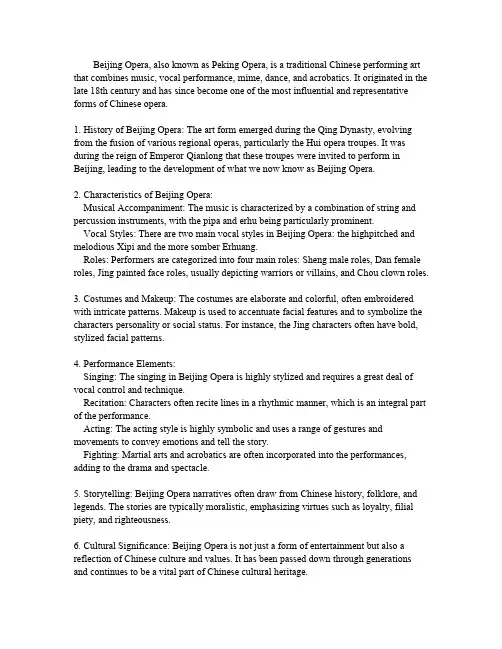
Beijing Opera,also known as Peking Opera,is a traditional Chinese performing art that combines music,vocal performance,mime,dance,and acrobatics.It originated in the late18th century and has since become one of the most influential and representative forms of Chinese opera.1.History of Beijing Opera:The art form emerged during the Qing Dynasty,evolving from the fusion of various regional operas,particularly the Hui opera troupes.It was during the reign of Emperor Qianlong that these troupes were invited to perform in Beijing,leading to the development of what we now know as Beijing Opera.2.Characteristics of Beijing Opera:Musical Accompaniment:The music is characterized by a combination of string and percussion instruments,with the pipa and erhu being particularly prominent.Vocal Styles:There are two main vocal styles in Beijing Opera:the highpitched and melodious Xipi and the more somber Erhuang.Roles:Performers are categorized into four main roles:Sheng male roles,Dan female roles,Jing painted face roles,usually depicting warriors or villains,and Chou clown roles.3.Costumes and Makeup:The costumes are elaborate and colorful,often embroidered with intricate patterns.Makeup is used to accentuate facial features and to symbolize the characters personality or social status.For instance,the Jing characters often have bold, stylized facial patterns.4.Performance Elements:Singing:The singing in Beijing Opera is highly stylized and requires a great deal of vocal control and technique.Recitation:Characters often recite lines in a rhythmic manner,which is an integral part of the performance.Acting:The acting style is highly symbolic and uses a range of gestures and movements to convey emotions and tell the story.Fighting:Martial arts and acrobatics are often incorporated into the performances, adding to the drama and spectacle.5.Storytelling:Beijing Opera narratives often draw from Chinese history,folklore,and legends.The stories are typically moralistic,emphasizing virtues such as loyalty,filial piety,and righteousness.6.Cultural Significance:Beijing Opera is not just a form of entertainment but also a reflection of Chinese culture and values.It has been passed down through generations and continues to be a vital part of Chinese cultural heritage.7.Modern Adaptations:In recent years,there have been efforts to modernize Beijing Opera by incorporating contemporary themes and technologies,ensuring its continued relevance and appeal to new audiences.8.Learning Beijing Opera:It is a highly disciplined art form that requires years of rigorous training.Young performers often begin their training at a young age,learning the various aspects of the art,including singing,acting,and martial arts.9.International Recognition:Beijing Opera has gained international recognition and has been performed in various countries,showcasing the richness of Chinese culture to the world.10.Preservation Efforts:There are ongoing efforts to preserve and promote Beijing Opera,including the establishment of schools and institutions dedicated to its study and performance.In conclusion,Beijing Opera is a multifaceted art form that offers a unique window into Chinese history,culture,and society.It is a testament to the creativity and artistry of the Chinese people and continues to captivate audiences both in China and around the world.。
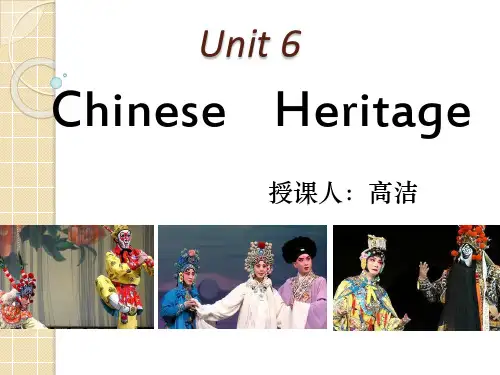
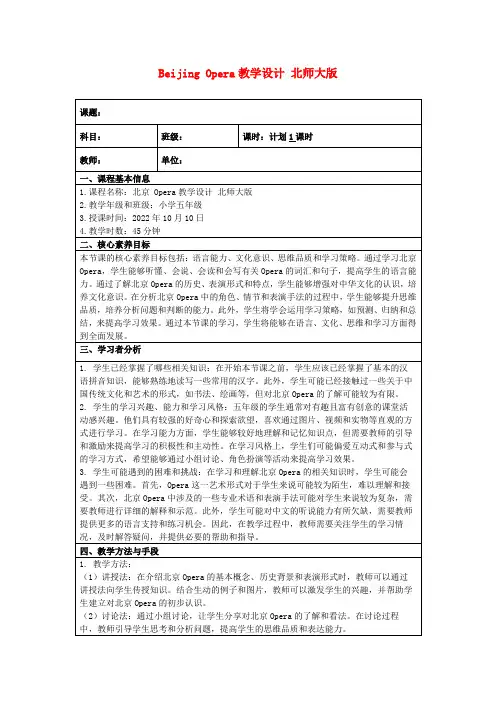
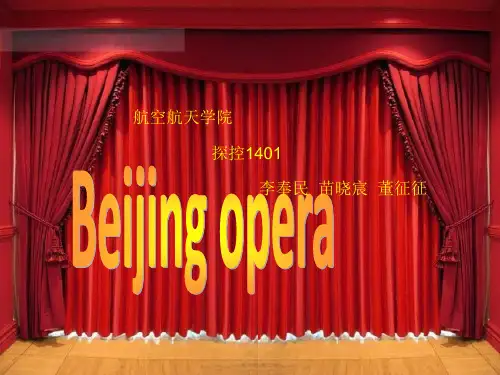
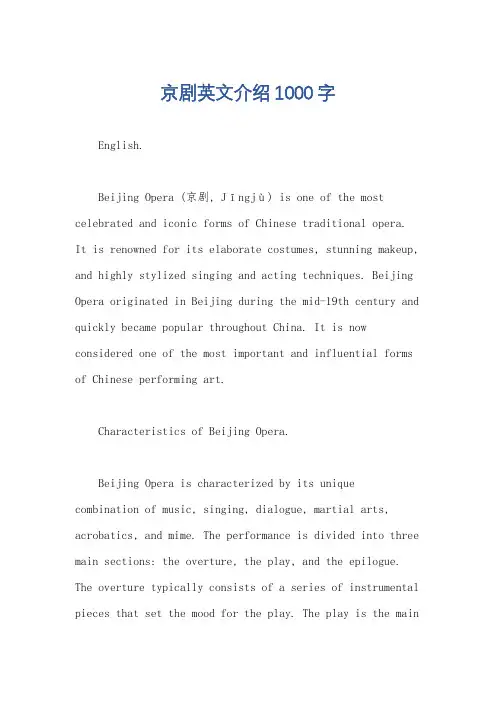
京剧英文介绍1000字English.Beijing Opera (京剧, Jīngjù) is one of the most celebrated and iconic forms of Chinese traditional opera.It is renowned for its elaborate costumes, stunning makeup, and highly stylized singing and acting techniques. Beijing Opera originated in Beijing during the mid-19th century and quickly became popular throughout China. It is now considered one of the most important and influential forms of Chinese performing art.Characteristics of Beijing Opera.Beijing Opera is characterized by its unique combination of music, singing, dialogue, martial arts, acrobatics, and mime. The performance is divided into three main sections: the overture, the play, and the epilogue. The overture typically consists of a series of instrumental pieces that set the mood for the play. The play is the mainpart of the performance and tells a story through a combination of singing, dialogue, and action. The epilogueis a short section that concludes the play and provides a moral or philosophical message.Beijing Opera is also known for its elaborate costumes and makeup. The costumes are often very colorful and adorned with intricate embroidery. The makeup is highly stylized and helps to create the characters' personalities and emotions.Performance Techniques.Beijing Opera actors undergo rigorous training tomaster the specialized performance techniques that are required for this art form. The singing is characterized by a high-pitched, nasal style that is unique to Beijing Opera. The actors also use a variety of hand gestures, body movements, and facial expressions to convey emotions and actions.Roles.Beijing Opera characters are classified into four main types: sheng (male), dan (female), jing (painted face), and chou (clown). Each type of role has its own unique set of conventions and techniques.Themes.Beijing Opera plays often explore themes of history, legend, love, and betrayal. They often draw on stories from Chinese mythology and folklore, as well as historical events.Influence.Beijing Opera has had a profound influence on Chinese culture and society. It has been featured in numerous films, television shows, and stage productions. The art form has also been exported to other countries around the world, where it has been adapted and incorporated into local performing arts traditions.Significance.Beijing Opera is considered a national treasure ofChina and is protected by the government. It is a livingart form that continues to evolve and adapt to modern audiences. Beijing Opera is a testament to the richcultural heritage of China and its enduring artistic traditions.中文回答:京剧,又称京戏,是中国传统戏曲中最著名、最具代表性的形式之一。
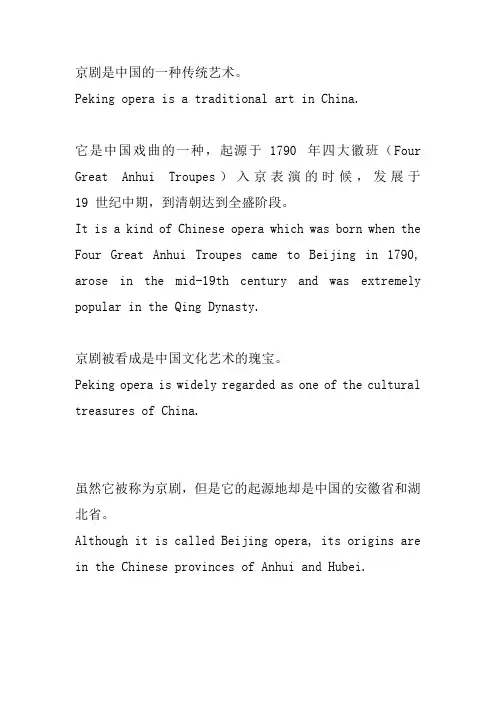
京剧是中国的一种传统艺术。
Peking opera is a traditional art in China.它是中国戏曲的一种,起源于1790 年四大徽班(Four Great Anhui Troupes)入京表演的时候,发展于19 世纪中期,到清朝达到全盛阶段。
It is a kind of Chinese opera which was born when the Four Great Anhui Troupes came to Beijing in 1790, arose in the mid-19th century and was extremely popular in the Qing Dynasty.京剧被看成是中国文化艺术的瑰宝。
Peking opera is widely regarded as one of the cultural treasures of China.虽然它被称为京剧,但是它的起源地却是中国的安徽省和湖北省。
Although it is called Beijing opera, its origins arein the Chinese provinces of Anhui and Hubei.京剧先是一种宫廷表演艺术,而后才慢慢普及到民间。
Beijing opera was originally staged for the court and came into the public later.在数百年前,京剧作为一种新的戏曲形式,无论在哪里进行表演,都饱受欢迎。
Hundreds of years ago, as a new style of drama, wherever they have been performed, they would be warmly welcomed.而在现代社会中,京剧等传统戏曲却不大能被年轻人接受,面临着巨大的生存危机。

京剧相关英语介绍Beijing OperaFour Famous Dan Actors 四大名旦;Stage Props in Peking Opera 京剧道具Types of Facial Make-up in Beijing Opera 京剧脸谱Roles in Beijing Opera 京剧的角色;Xipi and Erhuang 西皮和二簧Wenchang and Wuchang 文场和武场;Piao You and Xia Hai 票友和下海Longtao and Figurant "龙套”和“跑龙套”;Qiba “起霸” ;Liangxiang “亮相”In 1927, an open selection of the top Dan actors, sponsored by the Shuntian Times newspaper, was launched. As a result, Mei Lanfang (1894-1961), Shang Xiaoyun (1900-1976), Cheng Yanqiu and Xun Huisheng (1900-1968) were the most outstanding in the selection, and were named the four most famous Dan actors of Peking Opera at this time, each having his own unique characteristics in regard to action, expression and music. In addition, each had his own special repertoire, and these have been handed down from generation to generation. Eventually, they formed the four main schools of Peking Opera.Later, groups of excellent young actors were active on the opera stages, among whom the most famous were: Li Shifang, Zhang Junqiu, Mao Shilai and Song Dezhu, selected by the Liyan Newspaper. Each of the four had his own special repertoire, and their wonderful performances were well received by the mass. Eventually, they were recognized as the four sub-leading Dan actors of Peking Opera.China entered the modern era amidst turbulence and change in the 20th century. The Revolution of 1911 put an end to the 2,000-year rule of the feudal dynasties. Thus there was a spate of famous actors and actresses and schools of Peking Opera in the early decades of this century.二十世纪20年代年京剧旦行先后成名的四位有代表性的演员:梅兰芳、尚小云、程砚秋、荀慧生。

beijing opera的介绍英语作文Beijing Opera, often regarded as one of the quintessential Chinese traditional art forms, is a captivating and vibrant theatrical performance that combines various artistic elements such as singing, dancing, acting, and acrobatics. 京剧,被认为是中国传统艺术的代表之一,是一种富有魅力和活力的戏剧表演形式,融合了唱歌、舞蹈、表演和杂技等多种艺术元素。
Originating in the late 18th century, Beijing Opera has a long and rich history that reflects the cultural heritage of China. Its elaborate costumes, elaborate makeup, and distinctive vocal styles are iconic symbols of Chinese performing arts. 京剧起源于18世纪后期,有着悠久而丰富的历史,反映了中国的文化遗产。
其精美的服装、精致的化妆和独特的声乐风格是中国表演艺术的标志性符号。
One of the most striking features of Beijing Opera is the use of stylized movements and gestures to convey emotions and characters. Performers master a set of highly symbolic gestures known as "jingju shi," which are used to represent various emotions, actions, and characteristics. 京剧最引人注目的特点之一是使用程式化的动作和手势来传达情感和角色。
beijing opera英语作文高中Beijing Opera: A Captivating Fusion of Art, History, and TraditionBeijing Opera, also known as Peking Opera, is a unique and captivating form of traditional Chinese theater that has captivated audiences for centuries. This elaborate and multifaceted art form combines elements of music, dance, acrobatics, and stunning visual displays to create a truly mesmerizing experience. As one of the most well-known and iconic cultural traditions of China, Beijing Opera holds a special place in the hearts of both locals and international audiences alike.At the core of Beijing Opera lies a rich and complex history that dates back to the 18th century. The origins of this art form can be traced to the merging of various regional opera styles, each with its own distinct characteristics and traditions. Over time, Beijing Opera evolved into a highly refined and sophisticated genre, incorporating elements from Kun opera, Hui opera, and other regional performance traditions. This fusion of diverse influences has resulted in a truly unique and captivating art form that continues to captivate audiences around the world.One of the most striking features of Beijing Opera is its intricate and visually stunning costumes and makeup. Performers are adorned in elaborate, brightly colored garments that often feature intricate embroidery and intricate patterns. The use of elaborate headdresses, masks, and face paint is also a hallmark of Beijing Opera, with each character having a distinct and recognizable appearance. This attention to detail is not merely aesthetic but also serves to convey the personality and role of each character within the performance.The music of Beijing Opera is equally captivating, with a unique and complex musical structure that blends traditional Chinese instruments with Western-influenced elements. The orchestra, known as the Jingju, is composed of a variety of traditional Chinese instruments, including the erhu (a two-stringed fiddle), the pipa (a four-stringed lute), and the dizi (a bamboo flute). These instruments, along with percussion and vocal elements, create a rich and powerful soundscape that is both mesmerizing and emotionally evocative.The vocal styles of Beijing Opera are equally distinctive, with performers utilizing a range of techniques that include high-pitched trills, vibrato, and intricate melodic ornamentation. The singing is often accompanied by a unique style of recitation, known as "Xipi" and "Erhuang," which adds an additional layer of complexity and depth to the performance.In addition to the music and visual elements, Beijing Opera is also renowned for its acrobatic and choreographic elements. Performers often engage in intricate and physically demanding movements, including leaps, tumbles, and high-flying stunts. These acrobatic feats are seamlessly integrated into the storytelling, adding an additional layer of excitement and drama to the performance.The stories and narratives of Beijing Opera are equally captivating, drawing from a rich tapestry of Chinese history, mythology, and folklore. These stories often explore themes of love, loyalty, and heroism, with complex and multi-layered characters that capture the imagination of the audience. From the tragic love story of the Butterfly Lovers to the epic tale of the Monkey King, Beijing Opera's repertoire is a testament to the depth and richness of Chinese cultural heritage.Despite the enduring popularity of Beijing Opera, the art form has faced numerous challenges in recent decades. The rise of modern entertainment and the changing cultural landscape have led to a decline in the popularity of traditional theater, with younger generations often finding it difficult to connect with the complex and highly specialized nature of Beijing Opera. However, there are ongoing efforts to preserve and revitalize this art form, with organizations and institutions working to promote its appreciation and understanding both within China and on the global stage.In conclusion, Beijing Opera is a truly remarkable and captivating art form that embodies the rich cultural heritage of China. From its intricate costumes and stunning visual displays to its complex musical structure and captivating storytelling, Beijing Opera is a testament to the enduring power of tradition and the human spirit. Whether you are a seasoned aficionado or a newcomer to this art form, the experience of witnessing a Beijing Opera performance is one that will leave a lasting impression on your heart and mind.。
评价beijing opera英语作文Beijing Opera, also known as Peking opera, is one of the most famous traditional Chinese performing arts forms. With its unique blend of music, dance, acrobatics, and acting, Beijing Opera has captivated audiences both in China and around the world for centuries. In this essay, we will delve into the beauty and significance of Beijing Opera, examining its history, characteristics, and cultural impact.Originating in the late 18th century during the Qing Dynasty, Beijing Opera has a rich history that dates back over 200 years. It was developed in Beijing as a combination of various regional opera traditions, including Kunqu, Yiyang, Hanju, and Luantan. Over time, Beijing Opera evolved into a distinct art form with its own unique style and characteristics.One of the defining features of Beijing Opera is its elaborate costumes and makeup. Performers wear colorful, intricately designed costumes that represent different characters and roles in the opera. The makeup, known as "jing," is equally elaborate, with each color and pattern symbolizing specific character traits and emotions. For example, red makeup symbolizes bravery and loyalty, while white makeup represents treachery and villainy.Another hallmark of Beijing Opera is its distinctive singing style, known as "jingju." Performers use a combination ofsing-song dialogue, recitative, and vocal embellishments to convey the emotions and motivations of their characters. The music, which is accompanied by traditional Chinese instruments such as the erhu, pipa, and gong, adds depth and atmosphere to the performances.In addition to singing, Beijing Opera also incorporates elements of dance and acrobatics. Performers execute intricate dance movements and acrobatic feats to enhance the storytelling and create a visually captivating performance. These physical skills require years of training and discipline, making Beijing Opera one of the most demanding and respected art forms in China.The stories presented in Beijing Opera are often drawn from Chinese history, literature, and mythology. They typically revolve around themes of loyalty, honor, and righteousness, with characters facing moral dilemmas and epic challenges. Through its storytelling, Beijing Opera not only entertains audiences but also imparts moral lessons and cultural values.Beijing Opera has had a profound impact on Chinese culture and society. It has played a significant role in preservingtraditional Chinese art forms and promoting national identity. The art form has also influenced other forms of Chinese performing arts, such as martial arts, dance, and music.In recent years, Beijing Opera has gained international recognition and popularity. It has been performed in venues around the world, exposing audiences to the beauty and complexity of Chinese culture. With its timeless stories and vibrant performances, Beijing Opera continues to enchant and inspire people of all ages and backgrounds.In conclusion, Beijing Opera is a treasure of Chinese cultural heritage that deserves appreciation and recognition. Its unique blend of music, dance, acrobatics, and acting creates a mesmerizing spectacle that captivates audiences and transcends language and cultural barriers. As we celebrate the beauty and significance of Beijing Opera, we honor the rich tradition and artistry of this ancient art form.。
评价beijing opera英语作文Beijing Opera, also known as Peking Opera, is a traditional Chinese form of theater that combines music, singing, mime, dance, and acrobatics. It has a history of over 200 years and is considered one of the most important cultural treasures of China. The art form has evolved over time, blending elements of popular Chinese drama, folk music, and traditional opera styles.One of the distinguishing features of Beijing Opera is its elaborate and colorful costumes. The performers wear elaborate costumes and makeup to represent different characters, such as warriors, scholars, or emperors. The costumes are designed to symbolize the character's personality and role in the story. The makeup, known as "jing," is also highly stylized and serves to enhance the performer's facial expressions and emotions.Another key aspect of Beijing Opera is the music, which is characterized by its high-pitched singing and melodic instrumentation. The music is an essential part of the performance, conveying the emotions and actions of the characters. The performers are skilled in both singing and playing traditional Chinese musical instruments, such as the bamboo flute, drum, and gong.In addition to music and costumes, Beijing Opera is also known for its acrobatic performances. The performers execute complex movements and stunts, such as somersaults, flips, and jumps, to enhance the dramatic effect of the performance. These acrobatic feats require years of training and physical conditioning.One of the most famous aspects of Beijing Opera is its storytelling. The performances are based on traditional Chinese legends, myths, and historical events. The stories often revolve around themes of loyalty, honor, and justice. The actors use a combination of gestures, facial expressions, and movements to convey the emotions and motivations of the characters.Overall, Beijing Opera is a unique and captivating art form that showcases the rich cultural heritage of China. It has been recognized by UNESCO as an intangible cultural heritage of humanity. The performances continue to attract audiences both in China and around the world, and serve as a testament to the enduring legacy of this ancient art form.。
向外国朋友介绍京剧的英语作文Beijing Opera, also known as Peking Opera, is a traditional Chinese art form that has been passed down for centuries. 京剧,又称北京opera,是一种传统的中国艺术形式,已流传了几个世纪。
It is characterized by its unique combination of singing, acting, martial arts, and acrobatics. 它以独特的歌唱、表演、武术和杂技的组合而闻名。
The performers wear elaborate costumes and makeup, and the performances often include colorful props and intricate choreography. 演员身着精美的服装和化妆,表演中经常包含丰富多彩的道具和复杂的编舞。
Beijing Opera is not only a form of entertainment, but also a reflection of Chinese culture and history. 京剧不仅是一种娱乐形式,也是对中国文化和历史的反映。
One of the key elements of Beijing Opera is the use of distinct vocal styles. 京剧的一个关键元素是独特的声乐风格。
The performers use a combination of singing, chanting, and recitative to convey the emotions of the characters. 演员使用歌唱、吟诵和唱词结合的方式来传达角色的情感。
Beijing Opera, also called "Eastern Opera," is a principle tradition in Chinese culture. It is called Beijing Opera because it is formed in Beijing. Beijing Opera has a history of 200 years in which its fountainhead can be dated back to old local operas, especially Anhui Opera, which was very popular in northern China in the 18th century. In 1790, the first Anhui Opera performance was held in Beijing to celebrate the Emperor's birthday. Later, some other Anhui Opera troupes went on to perform in Beijing. Anhui Opera was easy to move and good at absorbing the acting styles of other types of operas. Beijing accumulated many local operas, which made Anhui Opera improve quickly.At the end of the 19th century and the beginning of the 20th century, after merging for 10 years, Beijing Opera finally formed, and became the biggest of all operas in China.Beijing Opera has a rich list of plays, artists, troupes, audiences, and wide influences, making it the foremost opera in China.Beijing Opera is a comprehensive acting art. It blends singing, reading, acting, fighting, and dancing together by using acting methods to narrate stories and depict characters. The roles in Beijing Opera include the male, female, painted-face, and comedic roles. Besides, there are other supporting roles as well. In addition, the types of facial make-up,especially concerning the color, are the most particular art in Beijing Opera, because they can symbolize the personalities, characteristics, and fates of the roles.It is widely acknowledged that the end of the 18th century was the most flourishing period in the development of Beijing Opera. During this time, there were lots of performances not only in folk places, but also in the palace. The noble class loved Beijing Opera; the superior elements in the palace played a positive role in the performances, make-up, and stage setting. The mutual influence between palace and non-government places promoted Beijing Opera's development.From the 1920's to the 1940's of last century was the second flourishing period of Beijing Opera. The symbol of this period was the emergence of lots of sects of the opera. The four most famous were "Mei" (Mei Lanfang 1884-1961), "Shang" (Shang Xiaoyun 1900-1976), "Cheng" (Cheng Yanqiu 1904-1958), and "Xun" (Xun Huisheng 1900-1968). Every sect had its groups of actors and actresses. Furthermore, they were extremely active on the stage in Beijing, Shanghai, and so on. The art of Beijing Opera was very popular at that time.Mei Lanfang was one of the most prominent Beijing Opera artists in the international world. He studied opera when he was 8, and began to perform on the stage when he was 11. In his more than 50 years ofperforming, Mei created and developed many acting phases, such as dancing, singing, make-up, and costumes, all of which helped him form his own style. In 1919, Mei led the opera troupe to Japan, which was the first time that China began to spread the art of Beijing opera overseas. In 1930, Mei Lanfang led a troupe to the United States and gained great success and significant recognition. In 1934, he was invited to visit Europe, and was given much attention by the European opera world. Later, other places in the world considered Beijing Opera as the performing sect of China.After the reform and opening-up policy, Beijing Opera had new development. Especially as the traditional quintessence of China, Beijing Opera got great support from the government. Today, the BeijingChang'an Opera House holds international competitions every year that attract many people from various countries. Beijing Opera is also the reserved program for the communication between Chinese and many foreign cultures.P eking opera of China is a national treasure with a history of 200 years. In the 55th year of the reign of Emperor Qianlong of the Qing Dynasty(1790) ,the four big Huiban opera Troupes entered the capital and combined with Kunqu opera, Yiyang opera, Hanju opera and Luantan in Beijing's thearetical circle of the time. Through a period of more than halfa century of combination and integration of various kinds of opera there evolved the present Peking opera, the biggest kind of opera in China, whose richness of repertoire, great number of artists of performance and of audiences, and profound influence are incomparable in China.Peking opera is a synthesis of stylized action, singing, dialogue and mime, acrobatic fighting and dancing to represent a story or depict different characters and their feelings of gladness, anger, sorrow, happiness, surprise, fear and sadness. In Peking opera there are four main types of roles: sheng (male) dan (young female), jing( painted face,male), and chou (clown, male or female). The characters may be loyal or treacherous, beautiful or ugly, good or bad, their images being vividly manifested. The repertoire of Peking opera is mainly engaged in fairy tales of preceding dynasties, important historical events, emperors, ministers and generals, geniuses and great beauties, from the ancient times to Yao, Shun, Yu, the Spring and Autumn Period, the Warring States Period and the dynasties of Qin, Han, Sui, Tang, Song, Yuan, Ming, Qing.The music of Peking opera is that of the "plate and cavity style".Its melody with harmonious rhythms is graceful and pleasing to the ears. The melody may be classified into two groups: "Xipi" and "erhong", guiding pattern, original pattern, slow pattern, quick pattern, desultary pattern being their chief patterns. The performance is accompanied by a tune played on wind instruments, percussion instruments and stringedinstruments, the chief musical instruments being jinghu (a two-stringed bowed instrument with a high register), yueqin( a four-stringed plucked instrument with a full-moon-shaped sound box), Sanxian( a three-stringed plucked instrument), suona horn, flute drum, big-gong, cymbals, small-gong, etc.The costumes in Peking opera are graceful, magnificent, elegant and brilliant, most of which are made in handicraft embroidery. As the traditional Chinese pattern are adopted, the costumes are of a high aesthetic value.The types of facial make-ups in Peking opera are rich and various, depicting different characters and remarkable images, therefore they are highly appreciated. Moreover there are numerous fixed editions of facial make-up.Since Mei Lanfang, the grand master of Peking opera, visited Japan in 1919, Peking opera has become more and more popular with people all over the world, and it has made an excellent contribution to cultural exchange between China and the West, to friendly association and to improvement of solidarity.Peking Opera house of Beijing has been invited to perform in U.S.A., England, France, Germany, Italy (three times), Australia, Japan( four times), Brazil, Turkey, Singapore, South korea and Hongkong (five times). The performances have made an outstanding contribution to Sino-foreigncultural exchange and to the promotion of friendly association of peoples in the world, and were highly appreciated by foreign audiences.In 1993 Peking Opera House of Beijing as a big Peking opera troupe made a performance visit to Taiwan, pushing the cultural exchange to a new height.Peking Opera house of Beijing is willing to participate in activities of international cultural exchange and of commercial performances and sincerely hopes that friends in various countries will make contacts with us about cultural exchange and performances.Peking opera or Beijing opera(simplified Chinese: 京剧; traditional Chinese: 京劇; pinyin: Jīngjù) is a form of traditional Chinese theatre which combines music, vocal performance, mime, dance, and acrobatics. It arose in the late 18th century and became fully developed and recognized by the mid-19th century.[1] The form was extremely popular in the Qing Dynasty court and has come to be regarded as one of the cultural treasures of China.[2] Major performance troupes are based in Beijing and Tianjin in the north, and Shanghai in the south.[3]The art form is also preserved in Taiwan, where it is known as Guoju (國劇; pinyin: Guójù). It has also spread to other countries such as the United States and Japan.[4] Peking opera features four main types of performers. Performing troupes often have several of each variety, as well as numerous secondary andtertiary performers. With their elaborate and colorful costumes, performers are the only focal points on Peking opera's characteristically sparse stage. They utilize the skills of speech, song, dance, and combat in movements that are symbolic and suggestive, rather than realistic. Above all else, the skill of performers is evaluated according to the beauty of their movements. Performers also adhere to a variety of stylistic conventions that help audiences navigate the plot of the production.[5] The layers of meaning within each movement must be expressed in time with music. The music of Peking opera can be divided into the Xipi (西皮) and Erhuang (二黄) styles. Melodies include arias, fixed-tune melodies, and percussion patterns.[6] The repertoire of Peking opera includes over 1,400 works, which are based on Chinese history, folklore, and, increasingly, contemporary life.[7]Peking opera was denounced as 'feudalistic' and 'bourgeois' during the Cultural Revolution, and replaced with the eight revolutionary model operas as a means of propaganda and indoctrination.[8] After the Cultural Revolution, these transformations were largely undone. In recent years, Peking opera has attempted numerous reforms in response to sagging audience numbers. These reforms, which include improving performance quality, adapting new performance elements, and performing new and original plays, have met with mixed success.。